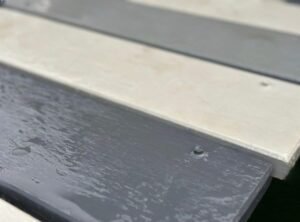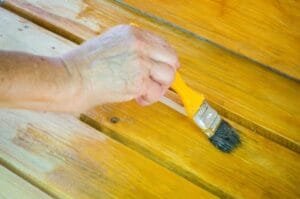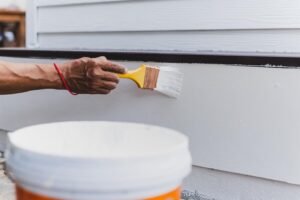Introduction to Weather-Resistant Paints
Weather-resistant paint is a specialized coating designed to offer protection against the adverse effects of environmental elements such as rain, sunlight, wind, and extreme temperature variations. These paints provide a durable shield that not only enhances the aesthetic appeal of surfaces but also significantly prolongs their lifespan. This is particularly crucial for outdoor applications where surfaces are continuously exposed to nature’s elements.
The main distinction between weather-resistant paints and standard paints lies in their formulation and performance characteristics. While conventional paints may suffice for indoor applications, they often lack the necessary properties to withstand the rigors of outdoor exposure. Weather-resistant paints are specifically engineered with advanced polymers and additives that impart superior adhesion, flexibility, and resistance to moisture. The result is a coating that can endure the fluctuating environmental conditions faced by outdoor surfaces.
Common materials used in the formulation of weather-resistant paints include acrylics, urethanes, and elastomeric compounds. These materials are adept at repelling water, resisting UV damage, and preventing the growth of mold and mildew. Acrylic paints, for instance, are known for their excellent elasticity and color retention, making them ideal for surfaces that expand and contract. Urethane paints, on the other hand, offer exceptional hardness and abrasion resistance, making them suitable for high-traffic areas or structures exposed to mechanical stress.
Aside from their protective properties, weather-resistant paints also contribute to energy efficiency by reflecting sunlight, helping to maintain a stable temperature within buildings. This not only reduces the strain on heating and cooling systems but also minimizes energy costs. Given the importance of safeguarding surfaces against nature’s challenging conditions, the adoption of weather-resistant paints has become a vital consideration for homeowners and builders alike.

Types of Weather-Resistant Paint
Weather-resistant paints are essential for protecting surfaces from the harsh effects of nature’s elements. They vary in composition and offer distinct benefits, making them suitable for different applications. This section delves into the various types of weather-resistant paint, providing a comprehensive overview for informed choices.
Acrylic paint is one of the most popular types of weather-resistant paint available. Made from a water-based formula, it contains pigment suspended in acrylic polymer emulsion. The primary advantage of acrylic paint is its flexibility and resistance to cracking. Additionally, it is less prone to fading and retains vibrancy longer when exposed to UV rays. Ideal for outdoor surfaces such as wood, metal, and masonry, acrylic paint is favored for residential exterior applications due to its ease of use and quick drying time.
Oil-based paint, in contrast, offers superior adhesion and durability, making it a traditional favorite for weather-resistant coatings. Comprised of pigments suspended in an oil medium, this type of paint dries slower but forms a harder finish once cured. It is particularly effective on surfaces exposed to moisture, such as metal and high-traffic areas. However, due to its volatile organic compounds (VOCs), it requires careful handling and ventilation during application.
Elastomeric coatings are designed specifically for surfaces prone to movement and cracking. These flexible, rubber-like paints expand and contract along with the underlying material, creating a waterproof barrier. They are particularly suitable for stucco and concrete surfaces, where movement may lead to cracks. The resilience of elastomeric coatings makes them an excellent choice for areas subject to severe weather conditions.
Lastly, specialty coatings cater to unique conditions, such as anti-graffiti or reflective coatings that minimize heat absorption. Depending on the specific environment and intended use, the choice among these diverse weather-resistant paints can significantly enhance surface longevity and performance.


Understanding Weather Conditions: What to Prepare For
Weather conditions significantly influence the durability and longevity of painted surfaces. Different climates present unique challenges that can lead to the deterioration of paint. One of the most critical factors is rainfall, which can cause direct damage to surfaces not protected with appropriate coatings. Excessive moisture can lead to issues such as peeling, blistering, and discoloration, especially for paints that are not water-resistant. For instance, mithila paints, known for their vibrant colors, need to be chosen carefully in regions with heavy rainfall.
Another factor to consider is UV exposure. Prolonged sunlight can degrade the chemical structure of the paint, causing it to fade and lose its protective qualities. Paints that lack UV resistance will struggle under the relentless sun, leading to frequent repainting and maintenance. Therefore, selecting high-quality weather-resistant paint, such as specialized mithila paints that offer UV protection, can ensure that the aesthetic appeal of surfaces is retained over time.
Extreme temperatures further complicate the longevity of painted surfaces. In climates with severe heat, paint can dry out and crack, while cold conditions may cause it to become brittle. It is essential to assess the temperature extremes in your area and choose paint products that can withstand such fluctuations without losing their integrity. Additionally, humidity is a critical consideration; high humidity levels can promote mold and mildew growth on painted surfaces, necessitating the use of mildew-resistant paints, like those found in the mithila collection.
In summary, understanding the various weather conditions that affect painted surfaces is vital for selecting the appropriate weather-resistant paint. By considering factors such as rain, UV exposure, extreme temperatures, and humidity, one can choose the right type of paint to ensure the longevity and beauty of their surfaces.
Benefits of Using Weather-Resistant Paint
Weather-resistant paint offers a multitude of advantages that extend the lifespan and aesthetic appeal of various surfaces. First and foremost, one of the primary benefits is its longevity. Traditional paints, while visually appealing initially, can degrade quickly when exposed to harsh weather conditions. In contrast, weather-resistant paint is formulated to withstand extreme temperatures, UV radiation, and humidity, significantly extending the period between necessary repainting. This characteristic not only saves time but also reduces costs associated with frequent maintenance and labor.
Furthermore, the enhanced protection against the elements is another substantial advantage. Weather-resistant paint acts as a barrier against moisture, preventing issues such as mold, mildew, and rot, particularly in areas prone to heavy rainfall or humidity. This protective layer is crucial for preserving the structural integrity of materials like wood and metal, which can corrode or decay if inadequately protected. Consequently, applying such paint contributes to the overall durability of the painted surfaces.
In addition to practical benefits, weather-resistant paint can also improve aesthetics. Freshly painted surfaces enhance the visual appeal of both residential and commercial properties. The availability of a wide array of colors and finishes allows homeowners and business owners to choose options that complement their design vision while benefiting from the durability of weather-resistant formulations. Some variants even provide insulation benefits by reflecting heat, thus contributing to energy efficiency. This can result in lower energy costs, particularly when light-colored paints are used on roofs, reflecting sunlight and reducing heat absorption.
Ultimately, investing in weather-resistant paint, often represented through products like mithila paints, yields long-term benefits that range from enhanced protection and improved aesthetics to reduced maintenance costs and potential energy savings, making it a wise choice for any property owner.
How to Properly Apply Weather-Resistant Paint
Applying weather-resistant paint requires careful preparation and attention to detail to ensure long-lasting protection for your surfaces. The initial step in this process is surface preparation, which entails cleaning the area to remove any dirt, grease, or previous paint remnants. For optimal adhesion, it is crucial to repair any surface imperfections, such as cracks or holes, and to sand down rough patches. A clean, smooth surface will enhance the paint’s bonding capabilities, leading to improved durability against the elements.
Choosing the right tools is equally important when applying mithila paints or other weather-resistant options. High-quality brushes or rollers designed for exterior use help achieve an even application, while sprayers can cover larger areas quickly. Ensuring the tools are appropriate allows for better control and minimizes the risk of drips or uneven coatings, both of which can compromise the finish and longevity of the paint.
When it comes to application techniques, the best practice is to follow a systematic approach. Start from top to bottom in order to catch any drips, and apply the paint in thin, even coats. Allowing adequate drying time between layers is essential, as it prevents issues such as bubbling or peeling. It is advisable to consult the manufacturer’s instructions on specific drying times, as these may vary based on environmental conditions and the type of paint used. Many weather-resistant paints also require a specific temperature range for application; adhering to these instructions will significantly enhance the protective qualities of the paint.
In conclusion, meticulous attention to surface preparation, careful selection of tools, and adherence to application techniques are crucial for properly applying weather-resistant paint. By following these guidelines, homeowners can ensure their surfaces are well-protected against nature’s elements, maximizing the benefits of mithila paints and similar products.

Common Mistakes to Avoid When Selecting and Applying Weather-Resistant Paint
When it comes to selecting and applying weather-resistant paint, homeowners and professionals alike may encounter several common pitfalls that can significantly undermine the effectiveness of their efforts. One of the primary mistakes is choosing the wrong type of paint. Various surfaces, such as wood, metal, and concrete, require specific formulations of paint to ensure proper adhesion and longevity. Utilizing mithila paints designed for the appropriate surface can ensure better results, as these products have unique properties tailored to withstand specific environmental challenges.
Another frequent error is neglecting surface preparation before application. Failing to clean, sand, or priming a surface adequately can lead to weak adhesion, resulting in peeling and chipping over time. To achieve the best results, it is essential to spend time preparing the surface, which might include power washing or scraping off all loose paint. Additionally, applying mithila paints without allowing adequate drying time can also compromise the finish, resulting in a subpar appearance. It is crucial to read the manufacturer’s guidelines for recommended drying times and environmental conditions.
Some individuals may also overlook the importance of weather conditions during application. Applying paint in extreme temperatures or humidity can drastically affect its adhesion and performance. Ideally, you should aim for moderate temperatures and low humidity to enhance drying and curing processes. Lastly, many overlook the importance of using primer before applying the topcoat. Primer not only helps in adhesion but also enhances hue and saturation, especially when using vibrant mithila paints.
By being mindful of these common mistakes, individuals can enhance their approach to selecting and applying weather-resistant paint, ultimately leading to a more durable and aesthetically pleasing finish that withstands the elements.
Maintaining Surfaces Painted with Weather-Resistant Paint
Proper maintenance of surfaces painted with weather-resistant paint is essential for prolonging the protective qualities that these specialized coatings offer. Regular cleaning is an important first step in the maintenance routine. Dust, dirt, and grime can accumulate on the surface over time, potentially compromising the paint’s integrity and appearance. Using a gentle detergent mixed with water and a soft cloth or sponge, clean the surfaces routinely—ideally, every few months—to remove any buildup. Avoid harsh chemicals or abrasive tools that could damage the finish.
In addition to cleaning, it is vital to perform routine inspections of the painted surfaces. Look for signs of wear and tear, including bubbling, cracking, or peeling of the paint. Such issues can expose the underlying materials to moisture and environmental elements, leading to more significant damage. If you do notice any damage, it is important to address it promptly. Depending on the severity, this could involve patching, scraping, or reapplying the weather-resistant paint to ensure continued protection.
Another aspect of maintenance is understanding when to reapply the weather-resistant paint. Even the highest quality mithila paints may eventually need reapplication due to sun exposure and other environmental factors. A good rule of thumb is to assess the condition of the paint every few years; if fading or deterioration is evident, it may be time for a fresh coat. Preparing the surface properly before reapplication is critical—cleaning, sanding, and priming as necessary will enhance the adherence and longevity of the new layer of paint.
By implementing a regular maintenance routine that includes cleaning, inspection, and timely reapplications, homeowners can significantly extend the lifespan of surfaces treated with weather-resistant paint, ensuring they remain beautiful and protected against nature’s elements.

Comparing Weather-Resistant Paint Brands: What to Look For
When selecting weather-resistant paint, consumers are often confronted with a vast array of brands, each boasting unique features and benefits. To make an informed decision, it is crucial to examine several key factors, allowing for a comprehensive comparison among the top contenders in the market. Durability emerges as one of the primary considerations. High-quality weather-resistant paints, such as those inspired by traditional mithila paints, should withstand harsh climates and resist peeling, chipping, or fading over time. The longevity of the paint not only speaks to the initial investment but also affects the frequency of repainting.
Another essential element is color selection. A wide range of shades can enhance the aesthetic appeal of a surface while providing effective protection. Brands that offer customizable color mixing options may cater better to individual preferences. Additionally, reviewing the environmental impact of a product is increasingly significant in today’s eco-conscious society. Consumers should seek paints with low volatile organic compounds (VOCs), as these options minimize harmful emissions, thereby contributing to better indoor and outdoor air quality.
Customer reviews serve as a valuable resource in the selection process. Analyzing feedback from users can provide insights into the practicality and performance of weather-resistant paints. Highlighting standout products, certain brands may emerge as favorites based on these user experiences, distinguishing themselves through superior benefits and satisfaction. Furthermore, look for brands that have established a reputation for reliable warranties and customer support, as these factors can indicate a commitment to quality and consumer trust.
In conclusion, the selection of weather-resistant paints is a multifaceted decision encompassing durability, color options, environmental considerations, and user satisfaction. By thoughtfully considering these aspects, consumers will be better equipped to choose a product that not only meets their needs but also complements their surroundings, drawing on the rich tradition of mithila paints as a source of inspiration.
Conclusion: Making the Right Choice for Your Projects
In navigating the world of weather-resistant paint, selecting the right product tailored to your specific needs is crucial. Weather conditions can vary significantly depending on your geographical location, making it essential to understand the requirements of various exterior surfaces. Mithila paints, known for their durability and protective qualities, serve as an excellent choice for those looking to safeguard their structures from the elements.
Firstly, it is important to consider the material you are painting. Different surfaces such as wood, metal, and masonry require distinct types of weather-resistant paint to ensure adequate adhesion and protection. For instance, mithila paints designed for wood not only enhance aesthetic appeal but also provide a barrier against moisture, preventing rot and decay. Similarly, paints developed for metals can help combat rust and corrosion, extending the life of outdoor structures.
Moreover, understanding the climate in your area will influence your choice. A humid environment may necessitate paint with superior mildew resistance, while a sun-drenched region would benefit from UV-resistant options. Additionally, it’s advisable to look for paints that offer flexibility and can withstand temperature fluctuations without cracking, which is a fundamental characteristic of quality mithila paints.
In summary, when selecting a weather-resistant paint for your projects, prioritize understanding your specific environmental conditions and the materials involved. By investing in high-quality paints such as mithila, you can ensure long-lasting protection that not only preserves the integrity of the surfaces but also enhances their appearance. Ultimately, making an informed decision will lead to better outcomes in maintaining and beautifying your properties amidst the diverse challenges posed by nature.
